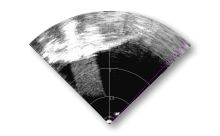Artemis's sonar makes it the ideal tool for finding objects in poor visbility diving conditions...
The "Tritech Micron Sonar" used on Artemis is a "forward looking, scanning sonar", meaning the sonar will build up an image of echoes it receives from targets in front of it by mechanically scanning a narrow (approx 3° horizontal width) wide acoustic sound beam horizontally through a 90° arc, performing "pings" at set intervals.
Artemis's sonar can be thought of like an acoustic 'torch' sweaping a beam of sound through the water in front of it, and 'illuminating' unseen targets.
When an object is "illuminated" within the sonar beam, the sound energy reflects off the target and is presented on the Artemis sonar display. The size of the object on the display is a function of the size of the target itself and the range at which it is observed.
For relocation of large objects, wrecks, jetties, underwater swimmer delivery vehicles and the like, it is possible to use the maximum range of 100m, and once the object has been detected the diver can close the range, changing the Range Scales as the target approaches.


Acoustic Shadows
Similar to an object casting a shadow when illuminated with a narrow torch beam, underwater targets can cast "acoustic shadows" in the sound beam, meaning any further targets behind them will not be visible if they lie fully within the shadow.
In the figure opposite, a selection of spherical and rectangular targets are in the sonar’s field of vision. As well as the shadows they create, the leading edges of the targets have been highlighted to surfaces the sound is reflected from, and ultimately this is what is shown on the display - the figure below shows a simplified view of this...



Gain Control
The gain control can be thought of like a "volume" control – increasing the gain will amplify fainter echoes making the entire display appear brighter (and possibly saturate some target detail), while decreasing the gain will dim the display (possibly hiding fainter targets, but making it possible to detect texture and detail on others).
Gain is mainly used to reduce the background clutter reflections in a high clutter (rocky/boulder) environment. By reducing the gain, the clutter and seabed reverberations can be reduced on the Sonar display making the initial detection of the target easier to see.
When scrutinizing a target at close range (within 3m range) in turbid or nil visibility, the gain is particularly useful in establishing the shape, constitution and dimensions of the target being prosecuted.





